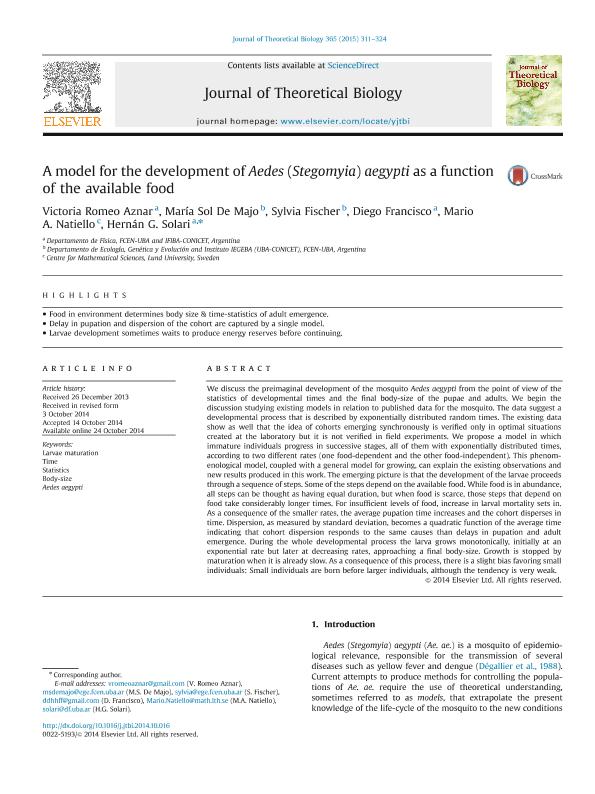Artículo
A model for the development of Aedes (Stegomyia) aegypti as a function of the available food
Romeo Aznar, Victoria Teresa ; de Majo, María Sol
; de Majo, María Sol ; Fischer, Sylvia Cristina
; Fischer, Sylvia Cristina ; Francisco, Diego; Natiello, Mario A.; Solari, Hernan Gustavo
; Francisco, Diego; Natiello, Mario A.; Solari, Hernan Gustavo
 ; de Majo, María Sol
; de Majo, María Sol ; Fischer, Sylvia Cristina
; Fischer, Sylvia Cristina ; Francisco, Diego; Natiello, Mario A.; Solari, Hernan Gustavo
; Francisco, Diego; Natiello, Mario A.; Solari, Hernan Gustavo
Fecha de publicación:
01/2015
Editorial:
Elsevier
Revista:
Journal Of Theoretical Biology
ISSN:
0022-5193
Idioma:
Inglés
Tipo de recurso:
Artículo publicado
Clasificación temática:
Resumen
We discuss the preimaginal development of the mosquito Aedes aegypti from the point of view of the statistics of developmental times and the final body-size of the pupae and adults. We begin the discussion studying existing models in relation to published data for the mosquito. The data suggest a developmental process that is described by exponentially distributed random times. The existing data show as well that the idea of cohorts emerging synchronously is verified only in optimal situations created at the laboratory but it is not verified in field experiments. We propose a model in which immature individuals progress in successive stages, all of them with exponentially distributed times, according to two different rates (one food-dependent and the other food-independent). This phenomenological model, coupled with a general model for growing, can explain the existing observations and new results produced in this work. The emerging picture is that the development of the larvae proceeds through a sequence of steps. Some of the steps depend on the available food. While food is in abundance, all steps can be thought as having equal duration, but when food is scarce, those steps that depend on food take considerably longer times. For insufficient levels of food, increase in larval mortality sets in. As a consequence of the smaller rates, the average pupation time increases and the cohort disperses in time. Dispersion, as measured by standard deviation, becomes a quadratic function of the average time indicating that cohort dispersion responds to the same causes than delays in pupation and adult emergence. During the whole developmental process the larva grows monotonically, initially at an exponential rate but later at decreasing rates, approaching a final body-size. Growth is stopped by maturation when it is already slow. As a consequence of this process, there is a slight bias favoring small individuals: Small individuals are born before larger individuals, although the tendency is very weak.
Palabras clave:
Larvae
,
Development
,
Food
,
Body-Size
,
Aedes Aegypti
Archivos asociados
Licencia
Identificadores
Colecciones
Articulos(IEGEBA)
Articulos de INSTITUTO DE ECOLOGIA, GENETICA Y EVOLUCION DE BS. AS
Articulos de INSTITUTO DE ECOLOGIA, GENETICA Y EVOLUCION DE BS. AS
Articulos(IFIBA)
Articulos de INST.DE FISICA DE BUENOS AIRES
Articulos de INST.DE FISICA DE BUENOS AIRES
Citación
Romeo Aznar, Victoria Teresa; de Majo, María Sol; Fischer, Sylvia Cristina; Francisco, Diego; Natiello, Mario A.; et al.; A model for the development of Aedes (Stegomyia) aegypti as a function of the available food; Elsevier; Journal Of Theoretical Biology; 365; 1-2015; 311-324
Compartir
Altmétricas



